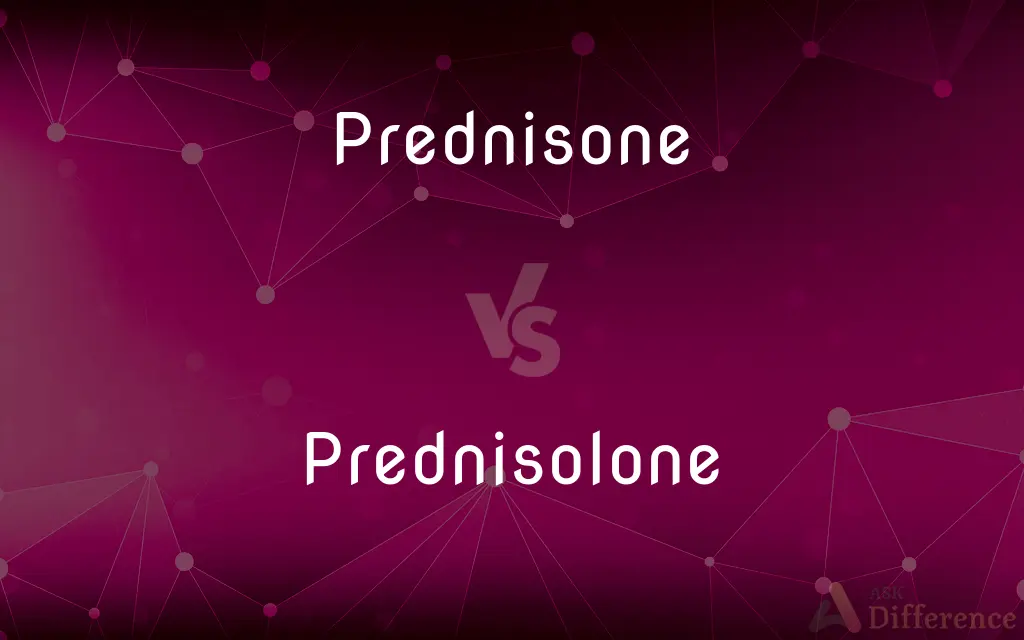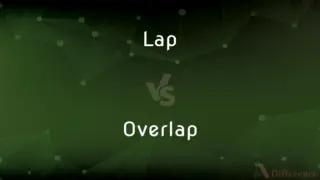Prednisone vs. Prednisolone — What's the Difference?
By Fiza Rafique & Urooj Arif — Updated on April 5, 2024
Prednisone is a synthetic corticosteroid used for its anti-inflammatory and immunosuppressive properties, requiring liver conversion to become active, whereas prednisolone is the active form, directly exerting its effects without needing conversion.

Difference Between Prednisone and Prednisolone
Table of Contents
ADVERTISEMENT
Key Differences
Prednisone is administered in its inactive form and relies on liver enzymes to be converted into prednisolone, its active form, making it slightly less potent initially. Whereas prednisolone is already in its active form upon administration, allowing it to work immediately in reducing inflammation and suppressing the immune system.
Prednisone is often prescribed for conditions like asthma, allergic reactions, and autoimmune diseases, relying on the body's metabolic processes to activate it. On the other hand, prednisolone is preferred in patients with liver conditions who might not efficiently convert prednisone into its active form, ensuring immediate therapeutic effects.
The side effects of prednisone, once converted into prednisolone, are similar to those of directly administered prednisolone, including increased risk of infections, osteoporosis, and blood sugar changes. However, the initial need for conversion can slightly delay the onset of side effects in prednisone use.
In terms of dosage, prednisone doses might be adjusted based on the individual's ability to convert it to prednisolone, especially in patients with liver impairment. Prednisolone, being directly active, can be more precisely dosed from the start, offering more immediate control over therapeutic levels.
Both medications are critical in managing inflammation and autoimmune conditions, but the choice between prednisone and prednisolone may depend on the patient’s specific health status, including liver function and the need for rapid onset of action. Physicians consider these factors to optimize treatment efficacy and minimize adverse effects.
ADVERTISEMENT
Comparison Chart
Form
Inactive prodrug
Active form
Activation
Requires liver conversion
Directly active without conversion
Preferred Use
General anti-inflammatory and immunosuppressive therapy
Cases requiring immediate effect or with liver issues
Onset of Action
Delayed until conversion
Immediate
Dosage Adjustment
May need adjustment for liver function
Can be more accurately dosed from the beginning
Side Effects
Similar to prednisolone once converted
Immediate potential for side effects
Compare with Definitions
Prednisone
Prednisone is a corticosteroid that requires liver activation to reduce inflammation.
Prednisone is often prescribed for severe allergic reactions.
Prednisolone
Prednisolone is an active steroid used to immediately combat inflammation.
Prednisolone eye drops are used for inflammation in the eye.
Prednisone
Prednisone is effective in treating autoimmune diseases by reducing immune response.
It's used in managing rheumatoid arthritis symptoms.
Prednisolone
Prednisolone treats a wide range of conditions, including allergies and arthritis.
It's effective in controlling allergic reactions and asthma flare-ups.
Prednisone
The medication's effectiveness can vary based on liver health.
Individuals with liver impairments may not fully benefit from prednisone.
Prednisolone
The drug can cause side effects like weight gain and mood swings.
Long-term use of prednisolone may require monitoring for side effects.
Prednisone
Prednisone is typically taken orally in pill form.
Daily prednisone pills are a common treatment for chronic asthma.
Prednisolone
It bypasses liver conversion, making it suitable for patients with liver issues.
Patients with liver disease may be prescribed prednisolone directly.
Prednisone
It is used to suppress the immune system and prevent organ rejection.
Prednisone can be part of a regimen to prevent kidney transplant rejection.
Prednisolone
It can be administered in various forms, including orally, topically, and by injection.
Prednisolone injections are used for acute flare-ups of arthritis.
Prednisone
A synthetic corticosteroid, C21H26O5, derived from cortisone and used as an antiallergy, immunosuppressive, and anti-inflammatory drug.
Prednisolone
A synthetic corticosteroid, C21H28O5, derived from cortisol and used as an anti-inflammatory, immunosuppressive, and antiallergic drug.
Prednisone
(pharmaceutical drug) A glucocorticoid C21H26O5 that is a dehydrogenated analog of cortisone, used to relieve rheumatic and allergic conditions and to treat leukemia.
Prednisolone
(pharmaceutical drug) A synthetic glucocorticoid C21H28O5 that is a dehydrogenated analog of cortisol and is used especially as an anti-inflammatory drug.
Prednisone
A dehydrogenated analogue of cortisol (trade names Orasone or Deltasone or Liquid Pred or Meticorten); used as an anti-inflammatory drug in the treatment of arthritis and as an immunosuppressant
Prednisolone
A glucocorticoid (trade names Pediapred or Prelone) used to treat inflammatory conditions
Common Curiosities
Can prednisone and prednisolone be used interchangeably?
They are often used for similar conditions, but their use depends on the patient's specific health needs, including liver function and the need for rapid onset of action.
How do doctors decide whether to prescribe prednisone or prednisolone?
The decision is based on factors like the required speed of therapeutic effect, patient's liver health, and specific condition being treated.
What is the key difference between prednisone and prednisolone?
The key difference is that prednisone requires liver conversion to become active (prednisolone), whereas prednisolone is active immediately upon administration.
How quickly does prednisolone work compared to prednisone?
Prednisolone works immediately upon administration, while prednisone's onset of action is delayed until it is converted into prednisolone by the liver.
Can both medications be used in pediatric patients?
Yes, both can be used in children, but dosages must be carefully adjusted based on the child's weight and condition.
Can either medication cause insomnia?
Yes, both prednisone and prednisolone can cause side effects like insomnia and mood swings.
Are there dietary restrictions while taking these medications?
Patients may be advised to follow specific dietary guidelines to manage side effects like weight gain and blood sugar levels.
Why is prednisolone preferred in patients with liver conditions?
Because prednisolone does not require liver conversion to be effective, making it more suitable for patients with impaired liver function.
Is prednisolone more expensive than prednisone?
Pricing can vary, but prednisolone may sometimes be more expensive due to its immediate bioavailability and different manufacturing processes.
Are the side effects of prednisone and prednisolone different?
Once prednisone is converted to prednisolone, the side effects are similar, including risk of infections, osteoporosis, and changes in blood sugar levels.
Can prednisone affect liver function over time?
Long-term use of corticosteroids, including prednisone, can have various effects on the body, but liver impairment specifically from prednisone is rare; monitoring is essential.
How long can one safely take prednisone or prednisolone?
The duration of therapy varies; long-term use requires monitoring for side effects, and stopping typically involves a gradual dose reduction.
Do prednisone and prednisolone affect vaccination efficacy?
These medications can suppress the immune system, potentially affecting the response to vaccines; timing and vaccination type should be discussed with a healthcare provider.
How are prednisone and prednisolone administered?
Both can be administered orally, and prednisolone can also be given as eye drops, injections, or topical treatments depending on the condition.
Is weight gain inevitable with prednisone or prednisolone treatment?
Weight gain is a common side effect, but it can be managed with dietary adjustments and physical activity.
Share Your Discovery

Previous Comparison
BHP vs. PS
Next Comparison
Lap vs. OverlapAuthor Spotlight
Written by
Fiza RafiqueFiza Rafique is a skilled content writer at AskDifference.com, where she meticulously refines and enhances written pieces. Drawing from her vast editorial expertise, Fiza ensures clarity, accuracy, and precision in every article. Passionate about language, she continually seeks to elevate the quality of content for readers worldwide.
Co-written by
Urooj ArifUrooj is a skilled content writer at Ask Difference, known for her exceptional ability to simplify complex topics into engaging and informative content. With a passion for research and a flair for clear, concise writing, she consistently delivers articles that resonate with our diverse audience.














































